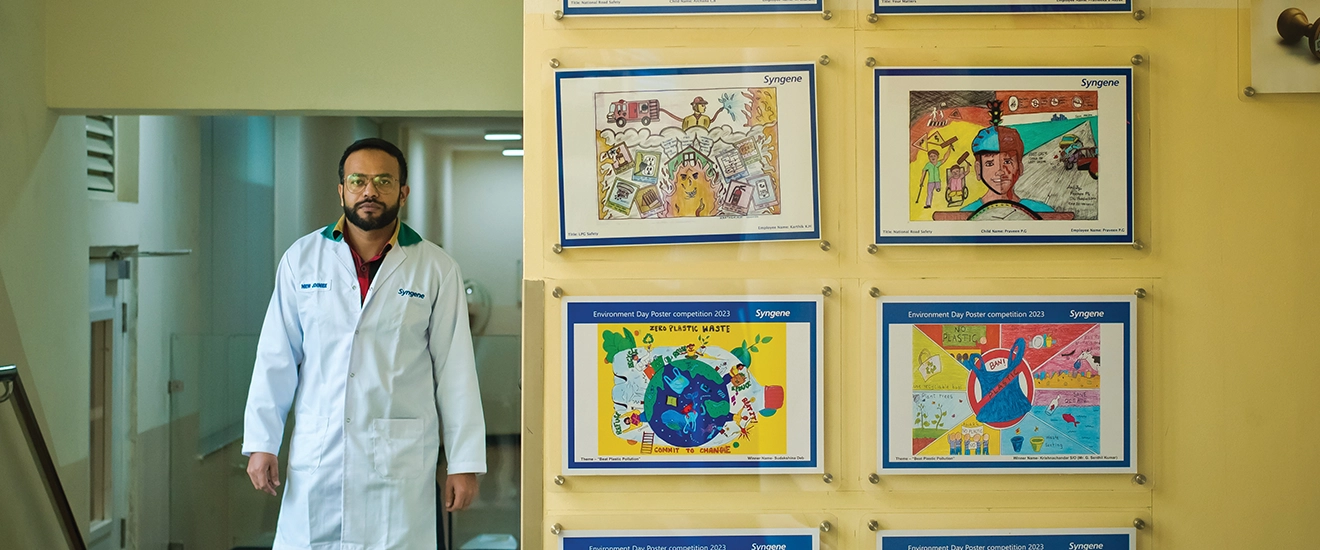

Poster campaigns around safety and sustainability for our employees and their children
The health, safety, and well-being of everyone who works on company premises is our top priority including employees, contractors, casual workers, vendors and visitors. To achieve this, a structured risk management and incident prevention system is used to minimize workplace hazards. Extensive training – both specialized and general training – is carried out on all campuses. In addition, employees are actively encouraged to report near misses to enable the Company to take preventive measures. In the case of an incident, every campus is equipped with occupational health facilities to offer initial diagnosis and treatment.
The organization upholds a ‘safety-first’ principle across its operations as part of our Environment, Health, Safety and Sustainability (EHSS) policy. This policy applies to all employees, both permanent and non-permanent, and aligns with the Suppliers Code of Conduct. During the year, 138 routine risk assessments were conducted to ensure the safe handling of hazardous chemicals, complex machinery and laboratory equipment, as well as responsible management of natural resources and waste. A structured review of company-wide warehouse safety was undertaken resulting in a program of improvements affecting all campuses and identified 759 actions for improving safety standards of our warehouses. This program also included improvement in hazardous substance management processes.44
44 GRI 3-3
Syngene maintains a well-embedded occupational health and safety management system across all its facilities, underpinned by the Environment, Health, Safety and Sustainability (EHSS) Policy. We maintain ISO 45001:2018 certification which provides the framework for occupational health and safety activity on each campus.45
The Company has implemented a risk management and prevention system based on Aspect Impact Management (AIM) and Hazard Identification and Risk Assessment (HIRA) principles46. We also maintain a strong process safety management (PSM) and fire safety system and regularly provide safety training to employees. Safety measures, such as the Earth Rite system, a distributed control system, powder transfer system, local exhaust ventilation, rupture disc, safety relief valves, dump tanks, water sprinklers, lower explosive limit (LEL) detectors and multi-gas detectors are installed as needed. Solvents are stored under hazardous area classification with appropriate safety features including breather valves and flame arrestors, in addition to dyke walls and sprinkler systems.
A safety committee was formed comprising representatives from each operating unit and essential function as well as an occupational health practitioner. This committee, along with the Toxic and Narcotics Safety Committee, is tasked with driving safety innovation and ensuring compliance.
https://cdn.syngeneintl.com/2022/08/24154649/Code-of-Ethics-and-Business-Conduct.pdf
Safety is a core value within the Company. It is the responsibility of every manager and employee to remain vigilant about maintaining a safe and secure working environment. Executive oversight of safety performance sits with the Executive Safety Committee which convenes quarterly and includes all members of the Executive Team and leaders of every operating unit and essential function. Additionally, safety risk and mitigation is a recurring agenda item at the Board’s quarterly Risk Committee meetings.47
During the quarterly reviews conducted by the Executive Safety Committee, each operating unit and essential function presents a self-assessment of preparedness on four dimensions including 21 parameters of health and safety using the framework established by the Centre for Chemical Process Safety. In cases where a unit or function does not meet the expected operating standards in any dimension, they are required to act immediately to develop a remediation plan to address these shortcomings.

45 GRI 403-1
46 GRI 403-2
47 GRI 403-3
Employee safety assembly point
A robust risk management and incident prevention system helps to anticipate and remediate potential hazards in order to minimize work-related hazards.
In addition to completion of the required training programs, an hour is set aside each week across the Company for teams to discuss a designated safety topic. Additionally, weekly safety information sheets are circulated to all employees including best practices, hints, and tips.49
On-site occupational health facilities offer day-to-day support to maintain employee well-being.50
Each campus has a dedicated emergency response plan and Emergency Response Teams covering all operations. During the year, mock drills were conducted fortnightly on each campus focusing on relevant incident scenarios to enhance preparedness. Firefighting training and workshops on process safety and emergency prevention also contributed to our readiness for on-site emergency response.
These facilities, installed at each campus, ensure that all vendors and contractors receive relevant safety training before undertaking any activities on campus.
The use of digital tools like ‘SynZero’ for safety incident reporting and an online portal for recording biosafety key performance indicators helped us to track and address safety incidents.
The audit process is an integral part of our safety management system. The audit program, including both internal and external audits by client teams and regulators, helps identify areas for improvement, strengthens compliance and fosters a culture of safety. In FY23, 8 (6 external, 2 internal) health and safety audits were carried out on our campuses.51
Syngene’s occupational health and safety management system covers the entire workforce. We conduct first-party audits (half-yearly) and second-party audits (annually) for all operating units. This systematic approach ensures that safety standards and compliance are regularly assessed and reviewed.
TUV Nord conducted a recertification audit on ISO 45001:2018 standards for our Bangalore and Mangalore facilities and both the facilities are now certified.
It’s important to note that the observations and recommendations from these audits are tracked, addressed and verified to ensure that we use the audit outcomes to learn and improve. Corrective actions and preventive actions (CAPA) are monitored by the relevant EHSS representative to ensure compliance and a systematic approach to addressing audit findings.
48 GRI 403-6 and RT-CH-320a.2
49 GRI 403-5
50 GRI 403-3
51 GRI 403-7

|
Covered by occupational health and safety management system |
8,614 workers |
|
|
Covered by occupational health and safety management system that is |
8,614 workers |
|
|
Covered by occupational health and safety management system that |
862 workers |
52 GRI 403-8
|
Number of hours worked (employees & workers) |
16,204,011 |
|
|
Fatalities (employees & workers) |
0 |
|
|
Rate of fatalities (employees & workers) |
0 |
|
|
High-consequence work-related injuries (excluding fatalities) (employees & workers) |
1 |
|
|
Rate of high-consequence work-related injuries (excluding fatalities) |
0.01 |
|
|
Recordable work-related injuries |
6 |
|
|
Rate of recordable work-related injuries |
0.07 |
|
|
Lost days (employees & workers) |
168 |
|
Fatalities as a result of work-related ill healths (employees & workers) |
0 |
|
|
Cases of recordable work-related ill healths (employees & workers) |
0 |
The Company adopts a proactive safety stance, rooted in the belief that every incident can be prevented. Over the past year, there has been a significant increase in the number of laboratory hazard assessments conducted, along with an uptick in project safety reviews. The issuance of work permits has also steadily risen from about 6,000 permits in FY22 to 6,400 in FY23, with the primary objective of offering our employees clear and precise directions regarding hazard identification and safety protocols.
To effectively track safety incidents and implement corrective measures, the Company has harnessed digital tools such as ‘SynZero’, a safety incident and near-miss reporting portal. Additionally, an online portal was introduced for the recording of biosafety key performance indicators, and ‘Chemwatch’, a digital safety data sheet, was implemented to ensure the safe use of chemicals. In order to mitigate the high risk associated with solvent usage, a zero-contact solvent dispensing system was introduced at our Bangalore campus. This innovation not only enhances the safety of the dispensing process but also minimizes the risk of fire in the warehouse. Furthermore, a centralized and fully automatic solvent system has been implemented in our Hyderabad campus.
Throughout the year, safety protocols have been diligently enforced through ‘Gemba’ safety walks, active employee participation in weekly safety hours, and thorough safety and incident management reviews. The Company has also actively observed events such as road safety week, chemical disaster prevention day, world environment day, and the 52nd national safety week.55
53 GRI 403-9
54 GRI 403-10
55 GRI 403-3, 403-4, 403-6 and RT-CH-320a.1.